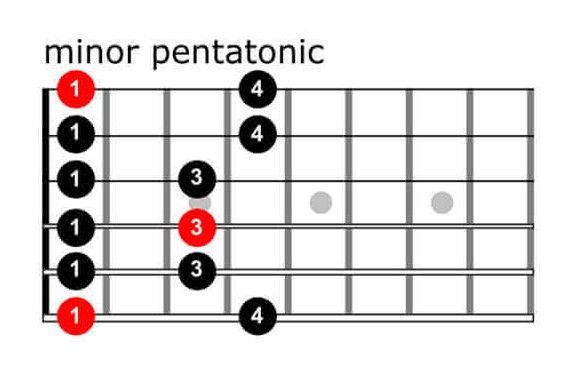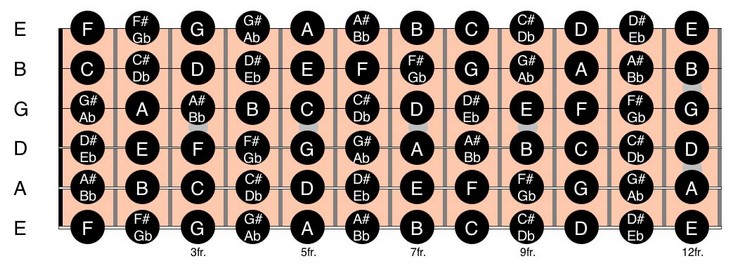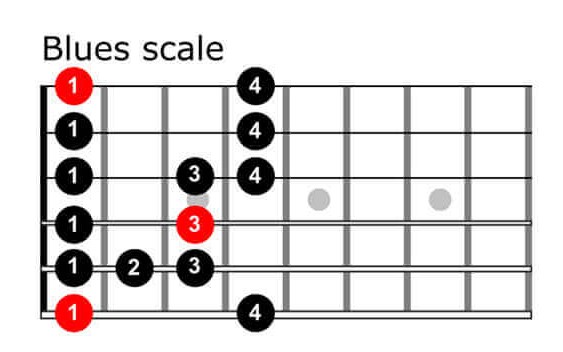A guitar scales chart is a valuable tool to have in your guitar toolkit. Let’s dive in!
In this scales chart mega-guide you’ll find:
- A scale chart for the Major Scale
- A scale chart for the Minor Scale
- A scale chart for the Major Pentatonic Scale
- A scale chart for the Minor Pentatonic Scale
- A scale chart for the Minor Blues Scale
- An overview of how to use these guitar scales charts
Over 250,000 guitar-learners get our world-class guitar tips & tutorials sent straight to their inbox: Click here to join them
An Introduction To Guitar Scales
Learning how to play the guitar will take us down all sorts of different paths of knowledge.
As each of us progresses through our individual guitar journey, we will branch out in different directions.
- In doing so, we end up learning a variety of skills that benefit our guitar playing. One of these key areas of knowledge lies in the realm of guitar scales.

Many musicians tend to argue on the importance of properly learning music theory and scales. Some will tell you that it’s unnecessary, and that you should learn with your ears.
- Others (ourselves included) favour the use of books and learning tools to learn as much about music as possible.
- We believe that you should never shy away from learning new musical abilities and theories.
Taking the time to improve our technique and our knowledge is vital to becoming a better guitarist – and who doesn’t love getting better at things?
After all, it’s not like it will hurt you to learn more about your instrument.
- Reading a guitar scales chart can be a bit intimidating, so we’re going to break it down for you so you can focus on learning.
- Before we dive into the what, let’s start with the why.

Why Are Scales So Important To Learn?
Guitar scales lie at the core of every guitar riff you’ve ever heard.
Scales are what give us the ability to create chords.
By organizing our twelve-note octave into smaller groups of notes, we are able to not only create amazing-sounding melodies, but corresponding chords as well.
An understanding of scales and how they function on guitar can help us gain a deeper understanding of music as a whole.
With this in mind, this process should not be overlooked.
One of the most popular ways to learn how to play scales on guitar is through the use of a guitar scales chart like the one below.

These can convey a lot of information to us.
- The red dots on the guitar scales chart show us where our root note of the scale is.
- The root note is the note that corresponds to the name of the scale.
(For example, the root note of C Minor Pentatonic is C.)
You will notice that the example does not show us any notes, and you might wonder why that is.
Pro Tip: These scales can be played in any of the twelve keys.
The key thing to know is where to root each scale shape.
- Due to the fact that every one of these scales begins on the low E string, we should find our root note there everytime.
- Take a look at the fretboard below to see where the notes lie on the E string as well as the other strings.
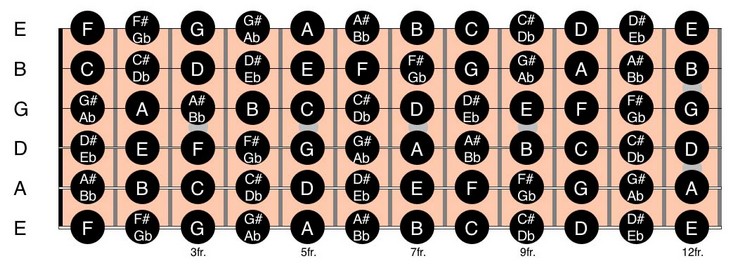
It’s also important to note that your fingers are most often numbered when reading a guitar scales chart. In the examples we use in this article, your fingers will be numbered as follows:
1 – Index
2 – Middle
3 – Ring
4 – Pinky
Pro Tip: Be sure to look out for spots in each scale shape where you may have to switch hand positions! This is a good skill to develop early on in your practice routine to help you navigate the fretboard easier.
For starters, let’s cover the major scale first. This will help us lay better groundwork for the rest of this lesson.

Download our lead guitar cheat-sheet to make things easier
It's hard to understand which scales work with which keys.
So we created a cheat-sheet! A key and scale-finder that you can use again and again.

Get your personalised guitar-learning plan 🎸
Get a custom guitar-learning plan here: Click here for GuitarMetrics™
World-Class Guitar Courses 🌎
Learn from the world's best guitar educators: Click here for our guitar courses
Guitar Scales Chart: The Major Scale
Ah yes, the happiest and the mother of all musical scales. The major scale gives us a wonderful foundation to use for learning other scales.
Everytime we discuss the major scale, we have to drop this video because it helps us gain a better understanding of this scale and how it functions. Click the link, then keep reading.
To start off, we should try to understand the seven degrees of the major scale. Check them out below:

Let’s break some of this down:
WS and HS refer to how many frets there are between each scale degree.
WS = Whole Step (2 frets distance)
HS = Half-Step (1 fret distance)
Let’s see what this looks like in a guitar scales chart:
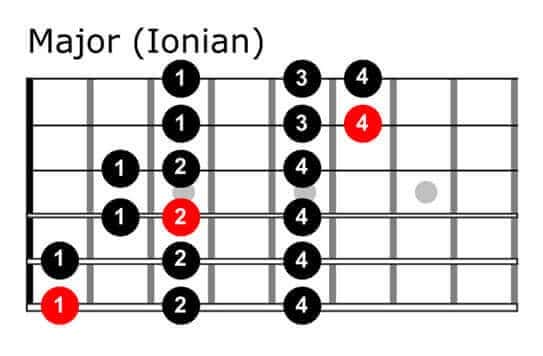
As you can see, each of these notes has a number, but no note attached to it.
This is because much like the guitar scales chart above, this series of notes can be played in any key.
Pro Tip: Begin this scale with your middle finger at any fret and us the fretboard chart in the section above to figure out what scale you are playing.
Your fingers are numbered so make sure you’re assigning one to each fret.
We’re going to play along to this scale in the key of G major at the 3rd fret as an example, so let’s have a look at what this scale looks like in tablature:

Here are some other keys you can easily play the major scale in, as well as their starting fret positions:
C: 8th Fret
A: 5th Fret
E: 12th Fret
D: 10th Fret
Guitar Scales Chart: The Minor Scale
This next scale comes directly from the major scale.
If we were to analyze this scale with the Do-Re-Mi chart above, our order of notes would look like this:

Pro Tip: We can also assign the same numeric structure to the notes of the minor scale itself, without using the major scale. That would look like this:
I II bIII IV V bVI bVII VIII/I
(See how the 3, 6 and 7 are flat? That is the difference between the major and minor scale’s makeup)

As you can see, the minor scale starts on the 6th degree of the major scale.
Why is this important?
It’s important because if we know this, we can always determine what the Relative Major key is of any minor key.
Let’s unpack that below this next guitar scales chart
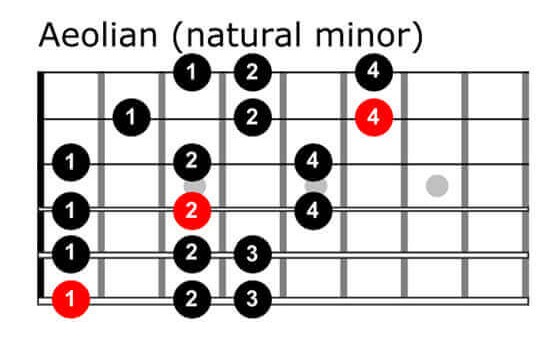
The ‘relative key’ is the key that uses the exact same notes as the key you are currently in.
- For every major key, there is a relative minor.
- For every minor key, there is a relative major.
- In the major scale, we can find the relative minor in the sixth note of the scale.
- In the minor scale, we can find the relative major in the third note of the scale.
- This is handy to know because it gives us two main positions to solo in.
- If you are playing in the key of G major like above, you can also solo in the key of E minor because they share the same notes.
We’ve tabbed out this guitar scales chart for you below:

Here are some other keys you can easily play the major scale in, as well as their starting fret positions:
C: 8th Fret
A: 5th Fret
G: 3rd Fret
D: 10th Fret
Guitar Scales Chart: The Major Pentatonic Scale
Remember how we said that the major scale was the mother of all scales?
This is why:
Now that you’ve got the major scale down, remove the 4th and 7th scale degrees.
- You are now left with five notes, where you once had seven.
- We refer to seven-note scales as diatonic scales, and we refer to five-note scales like these as pentatonic scales.
- This scale shape is very similar to the major scale, but your middle and ring fingers get less of a workout.
Let’s look at the guitar scales chart for the major pentatonic scale below, and then break it down:
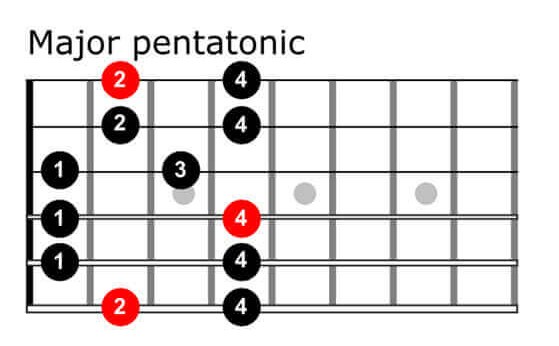
This scale is excellent for us in Blues music as well as Rock & Roll and many other genres.
The pentatonic scale also gets a lot of play for its simplicity in the Funk world.
You’re going to want to stretch your pinky finger for this one, as you’ll be making good use of it. Make sure once again to lead with your middle finger so that your index can lead on the A string above.
Pro Tip: The only way to get better at these scales is with time and practice.
Don’t hesitate to learn these scale shapes in all twelve keys, as it will only ever benefit your playing.
Here are some other keys to play this scale in:
C: 8th Fret
A: 5th Fret
E: 12th Fret
D: 10th Fret
Let’s take a look at the G major pentatonic guitar scales chart, tabbed out below:

Learn 12 EASY beginner chords with our popular guide

✅ Stop struggling. Start making music.
✅ Learn beginner-friendly versions of every chord.
This is our most popular guide and it will improve your chord ability quickly! 😎
Get your own personalised guitar-learning plan 🎸
Get a custom guitar-learning plan here: Click here for GuitarMetrics™
World-Class Guitar Courses 🌎
Learn from the world's best guitar educators: Click here for our guitar courses
Guitar Scales Chart: The Minor Pentatonic Scale
A stripped-back version of the minor scale, we remove the 2nd and 6th degrees of the scale to create this pentatonic version.
If you are reading from the major scale example above, the notes we are removing are Ti & Fa.
If you are reading from the minor scale example, it looks like this:
I bIII IV V bVII VIII/I
Much like the major pentatonic scale, the sound of the minor pentatonic scale makes it appealing for many guitarists who want to write hard-hitting and straightforward guitar licks.
Pro Tip: The guitar scales chart for the minor pentatonic scale is outlined below in two octaves like all of the ones above.
- Rather than shift our hand position upward like we do in the minor diatonic scale examples, we’ve outlined this one inside of one box shape.
- Box shapes are four frets wide and serve as your typical guitar scales chart outline.
To make it easy, we’re going to keep to the relative minor routine that we’ve established and look at this guitar scales chart in E minor.
Make use of those open strings as well as your index and middle fingers. If you’re opting to play this scale in a different key, you’re going to want to lead with your index finger, followed by your pinky.
Skill Tip: If you combine the G major scale shapes that you’ve learned already with the E minor shapes we have below, you get one bigger shape to play through.
- Take a look at the guitar scales chart for each shape and compare positions.
- This is great practice for learning how to put shapes together. It also helps us create a better mental map of the fretboard.
Check out the fretboard below the tab for reference.
Here are some other keys to play this scale in:
C: 8th Fret
A: 5th Fret
G: 3rd Fret
D: 10th Fret
Recommended resource: How To Play Lead Guitar
This is one of the most popular guides on the whole site, you’ll love it!
Guitar Scales Chart: The Minor Blues Scale
The last of our scales in today’s lesson, the minor blues scale is the rule-breaker of the bunch.
This scale has neither seven or five notes – Instead, it has six.
In order to understand this scale, we need to understand the structure of the minor scale a little bit better.
Remember this from the minor pentatonic scale section above?
I bIII IV V bVII VIII/I
Now add a bV in between the IV (4) and V (5)
That should look like this in a guitar scales chart:
This scale has a bluesy flair to it, but it can be put to use in everything from Rock and Metal to Funk and Country.
Try experimenting with it in different keys to get a feel for the sound of the scale and how it is different from the minor and major pentatonic scales.
Pro Tip: This scale can be used alongside the major and minor pentatonic scales when soloing to create unique sounds. Keep the rule of relative major in mind and connect this scale with the other scales you’ve learned in different keys.
Check out the different positions and keys you can play this scale in:
C: 8th Fret
A: 5th Fret
G: 3rd Fret
D: 10th Fret

What Can I Do With These Scales?
One of the best things you can do after learning scales is to find patterns within each guitar scales chart.
Look for unique two and three-note chords that you can play inside each scale shape, and you will help develop your ear and your hands.
- Writing riffs is another great way to utilize what we have learned.
- Put your technique to work and start finding your musical voice in every guitar scale chart through different note combinations.
- If you want to learn some more interesting info about scales, check out this article from Hello Music Theory.
We all have our own voice in music, and it’s in there waiting for you to crack it open.
So what are you waiting for? Keep practicing!
Where Do I Go From Here?
Want to know what to do next with all of the guitar scales chart content you just worked through? We recommend:
- Try writing some new riffs!
- Find new chord shapes
- Practice!
- Take these up with your guitar teacher to push your knowledge even further
- Jam these scales with your friends or at an open mic!
Recommended Resources
Here’s some more National Guitar Academy lessons you may enjoy:
- How To Play Barre Chords
- How To Teach Yourself Guitar In Ten Easy Steps
- 10 Easy Songs on Guitar
- How To Play Guitar Power Chords
- CAGED Guitar System
What Type of Guitarist Are You?
Take our 60-second quiz & get your results: Take The Quiz
Join the world's best online guitar school 🌎
- Get your own personalised guitar learning plan (customised just for YOU).
- World-class online guitar courses. Learn at your own pace.
- Community Campus & Learning Forum - A friendly community! Connect with our team & students. 😊
- Beginner Song library with chordsheets, tabs and tips. (Songs suitable for all levels!)
- Regular live streams, seminars and Q&A sessions - Learn from world-class guitar educators. Get all your questions answered!
Click here to learn more about National Guitar Academy membership 
Cool Guitar T-shirts 😎
Look cooler! Check out our merch: Click here to see our merch store
Want free guitar tips and video lessons delivered to your inbox?
Join over 250,000 other guitar learners and subscribe to our guitar-tips-by-email service. (It's free.)
We'll send you a series of lessons that will move you to the next level of your guitar journey.
Learn how everything fits together quickly, easily and effectively. We share ninja tips (for instant fun!) but also timeless fundamentals that will deepen your understanding.

Popular Lessons
How To Learn Guitar: An 11-Step Programme For Beginners
How To Choose The Perfect Beginner Guitar
More Cool Guitar Stuff
Learn about National Guitar Academy: About Us
Visit our YouTube channel for fun guitar videos.
Join us on Facebook for daily guitar tips.
Listen to our Learn Guitar Podcast for rapid guitar progress.
Check out our free chord lessons.
Get our best guitar tips & videos
Where should we send it?
Where should we send it?
Get our best guitar tips & videos

